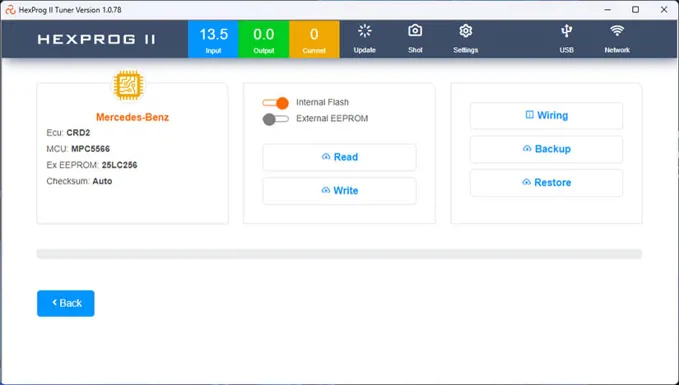CRD2 in Mercedes vehicles is a complex Engine Control Unit (ECU) and is one of the most challenging ECUs to work with during ECU Repair and ECU Programming. This particular ECU is known for its intricacy and unique characteristics. Unlike other ECUs, it can only be accessed through a specialized mode known as Boot Mode, in which the ECU needs to be physically opened to gain access to the internal components. This Boot Mode enables automotive technicians to perform ECU Cloning and ECU Repair Job. ECU Cloning refers to the process of creating an identical copy of the original ECU, while ECU Repair involves diagnosing and fixing issues within the ECU's circuitry, components, and ECU files.
Due to the limited accessibility through Boot Mode, this ECU presents a significant challenge to automotive technicians and engineers when it comes to diagnosing, ECU Repairing, and making modifications. Nevertheless, skilled professionals who possess in-depth knowledge and expertise can navigate this complex process, carrying out both ECU Cloning and ECU Repair procedures. Simultaneously, ECU Repair is an essential aspect when dealing with this challenging ECU. Due to its complexity, the ECU may occasionally experience hardware or software issues, leading to malfunctions in the vehicle's performance. Skilled technicians with expertise in ECU Repair can diagnose these issues, identify faulty components, and carry out the necessary repairs to restore the ECU's functionality.
In addition to the challenges posed by limited accessibility, making modifications to the ECU becomes a delicate task. Even minor changes to the ECU's Programming can have far-reaching implications on the vehicle's performance, emissions, and overall safety. Therefore, professionals must exercise extreme caution and proficiency when modifying the ECU to achieve specific performance enhancements or customizations, ensuring that the changes comply with relevant regulations and do not jeopardize the vehicle's reliability.
In conclusion, the limited accessibility through Boot Mode undoubtedly presents a significant challenge for automotive technicians and engineers when dealing with ECU diagnostics, repairs, and modifications. Nevertheless, the proficiency and expertise of skilled professionals empower them to navigate these complexities, ensuring that they can perform ECU Cloning, ECU Repairs, and ECU modifications with precision and efficiency, ultimately contributing to the seamless functioning and reliability of modern vehicles.
To achieve successful cloning and repair of this challenging ECU, automotive professionals leverage specialized tools and software. The popular tool that has gained recognition for this purpose is Hexprog II hardware, complemented by Hexprog II Tuner software. Hexprog II is specifically designed to interact with difficult-to-access CRD2 ECUs like the one found in certain Mercedes models. With this hardware and software combination, technicians can efficiently read, write, and repair the ECU's data and modify data for desired changes.
CRD2 Hardware Variants
The CRD2 ECU with MCU MPC5566 comes in 3 hardware versions for different vehicle models. Hexprog II is a versatile tool that supports both versions for tasks like cloning (copying ECU data) and chip tuning (performance optimization). It's crucial for experienced professionals to ensure proper and safe use of these functions. The comprehensive wiring diagram is available within the Hexprog II tuner software and covers three distinct hardware versions.
Below are the steps for cloning CRD2 ECU:
- Preparation: Before starting the cloning process, ensure you have the necessary tools and equipment. You'll need Hexprog II hardware and Hexprog II Tuner software with valid cloning and ECU license. You must use Hexprog II Tuner software to check the wiring diagram of the CRD2 ECU, and arrange soldering equipment and stay wires as necessary.
- Accessing Boot Mode: Since this CRD2 ECU can only be accessed through Boot Mode, the first step is to open the ECU and establish a connection to its internal circuitry along with external connections. This is usually done using specialized tools and boot and signal wires given with Hexprog II, and it requires a delicate touch to avoid damaging any components.
- Reading Original CRD2 ECU Data: Once the connection to the ECU is established, Hexprog II hardware, combined with Hexprog II Tuner software, is used to read and extract the data from the original CRD2 ECU. It is possible to read internal flash separately in .bin format that can be used for modification and Chip tuning. This data contains essential information about the vehicle's settings, calibration, and configurations
- Creating a Backup: The user needs to use the backup button to back up the whole ECU data. After successfully reading the data from the original ECU, backup files are created. This backup file contains all the information required to clone the ECU accurately. It is essential to store these backup files safely as it serves as the foundation for the cloning process.
- Preparing the New CRD2 ECU: If the goal is to clone the CRD2 ECU onto a new or refurbished one, the new CRD2 ECU must be prepared. This involves ensuring that the new CRD2 ECU is compatible with the vehicle and in working condition.
- Restoring Data onto New CRD2 ECU: With the new ECU prepared, the next step is to use Hexprog II hardware and Hexprog Tuner software to restore the original backup file onto the new ECU. This process transfers all the original settings and configurations to the new CRD2 ECU, effectively creating an identical copy of the original. Before restoring the original data we recommend users to make a backup of new or donor ECU for safety concerns in the future.
- Testing and Verification: After the cloning process is complete, it's essential to verify the functionality of the newly cloned ECU. The vehicle should be tested to ensure that all systems are working correctly and that there are no error codes or malfunctions.
- Finalization: Once the cloned CRD2 ECU is verified to be functioning properly, the ECU can be securely reinstalled in the vehicle. It is crucial to ensure that all connections are secure, and the ECU is properly seated.
ECU Cloning ensures that all the original settings and calibration data are preserved, allowing the vehicle to function properly without the need for extensive reprogramming.
It is important to note that both ECU Cloning and ECU Repair should only be performed by trained professionals or skilled technicians with a thorough understanding of the process. Any mistakes or errors during the cloning or repair procedure can have severe consequences for the vehicle's performance and security. While the cloning and repair processes themselves can be intricate and demanding, they offer valuable solutions for preserving the functionality of vehicles with challenging ECUs. They allow automotive specialists to offer effective solutions to their customers, ensuring their vehicles continue to operate optimally and reliably. As the automotive industry continues to advance, with vehicle technology becoming increasingly sophisticated, the expertise in ECU Cloning and ECU Repair will undoubtedly play a crucial role in the maintenance and repair of modern vehicles. With each passing year, automotive manufacturers are incorporating more complex electronic control units (ECUs) into their vehicles, which are responsible for managing various functions and systems within the automobile. So Hexprog II Tuner software and Hexprog II hardware combined can make a difference between professional and non-professional task like this.
Other Services Supported
In the realm of automotive performance and tuning, there are various methods available to modify the Engine Control Unit (ECU) beyond just cloning. One such alternative technique in ECU Repair involves reading the internal flash of the ECU and making adjustments to the file to achieve specific modifications, such as disabling AdBlue, DPF (Diesel Particulate Filter), EGR (Exhaust Gas Recirculation), and other emission-related systems. ECUs play a crucial role in modern vehicles, as they control and manage various engine parameters, ensuring optimal performance, fuel efficiency, and emission compliance. However, automotive enthusiasts and tuners often seek to unleash the full potential of their vehicles by customizing the ECU's settings to suit specific driving preferences or performance goals.
To achieve these customizations, some tuners opt for ECU Cloning, which essentially involves copying the existing ECU's data onto a new hardware unit. This can serve as a starting point for further Chip Tuning, allowing them to experiment with different settings while preserving the original ECU's data for later use. However, beyond cloning, there exists a more intricate method of accessing the ECU's internal flash memory directly. By doing so, skilled tuners can read and analyze the hexadecimal code that governs various engine functions. This access allows them to apply modifications to the file, effectively turning off certain systems like adblue, dpf, and egr.
Additionally, we offer an exclusive online service to support the functionalities mentioned above. And can access direct from there account at www.hexprog.com.
When a file is modified, it can be seamlessly written back into the system with an auto checksum feature in Hexprog II Tuner, ensuring data integrity and accuracy. Moreover, any modifications made to the internal flash are effortlessly written back with checksum correction using our cutting-edge Hexprog II Tuner software. This ensures that the data remains secure and error-free throughout the entire process.
When it comes to internal flash, our Hexprog II Tuner software is the perfect tool to manage and write back the modified data. The software offers a wide range of features, such as checksum correction, version control, and real-time data monitoring. Users can confidently apply their changes and have peace of mind knowing that the system will maintain its stability and reliability.
With our comprehensive suite of online services and powerful software solutions, customers can easily manage, modify, and update their systems with confidence and precision. Whether it's checksum verification, flash programming, or any other online support, our platform is built to deliver exceptional performance and results.
More Info about CRD2
Hexprog II is a specialized ECU chip tuning tool that can read and write all contents of the CRD2 ECU Boot mode. For more detailed information about the CRD2 and the capabilities of Hexprog II tool, you can refer to the following links:
Hexprog II CRD2: Details
Hexprog II product page: HEXPROG II ECU CHIP TUNING TOOL
Hexprog II ordering page: Hexprog II Order
Please visit the provided links to learn more about the CRD2 ECU and Hexprog II tool for ECU chip tuning




